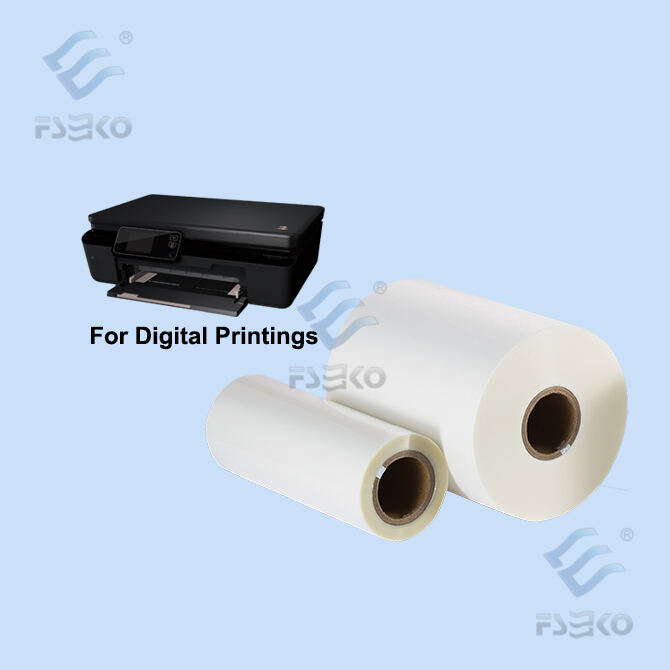Benefits of Adhesive Lamination Film in Modern Packaging
Enhanced Durability for Long-Lasting Protection
The adhesive lamination film greatly improves the functionality of the package, as well as the aesthetic appeal. This increased durability is important for preserving the packaging's structural soundness, particularly in the case of items that will be handled often or that will endure rough treatment. Research has shown that the use of adhesive lamination increases the lifetime of packaging, and thus minimizes the waste at consumers and enhances customer satisfaction. 1 For example, electronics as a high value item gain protection from physical and chemical degradation, adding to the product's shelf life.
Superior Barrier Properties Against Moisture & Contaminants
Adhesive Lamination Films These films provide a saturated adhesive bond, that is essential in barrier films such as, water and dust proof foil packaging. This is an important function in the maintenance of the quality and safety of fresh items. These barrier characteristics can be tailored, depending on the type and thickness of the material, to suit particular needs within, for example, sectors such as food or healthcare, research has shown. For example (laminated) food packaging can increase the shelf life of foodstuff by 50%, making food safer and greatly decreasing waste.
Aesthetic Improvements for Brand Visibility
The appearance of packaging is also enhanced by the use of adhesive lamination films, which impart glossy, matte, or textured finishes that attract the attention of consumers. Brand visibility can be increased by these improvements which in turn improve aesthetic, as market research has shown a relationship between appealing packaging aesthetics and consumer purchasing habits. What’s more, brands can differentiate in a cluttered marketplace with special lamination effects, gaining brand recognition and brand loyalty. This strategic packaging is important to companies that need to set themselves apart in an increasingly competitive retail environment.
Key Applications Across Industries
Food Packaging: Preserving Freshness & Safety
Food Packaging industry greatly makes use of these adhesive lamination films to ensure that the product is well protected against moisture and oxygen – both are needed to retain the freshness of any packed product. These films meet FDA requirements to ensure safety and help to prevent contamination of food-handling products---since safety is a major concern among food manufacturers. Importantly vacuum sealed packages made with the film have long shelf life and improved food safety which are issues of concern for both consumers and waste in food preservation.
Medical Supplies: Sterility Assurance
Adhesive lamination films are also critical to healthcare by providing the means to hermetically seal medical supplies and keep them sterile. These films are widely used by hospitals and 6 cliniques to wrap up medical instruments and equipment so that they are protected against contamination until they are used. Data indicates a significant reduction of infection rates in healthcare facilities utilising laminated packaging. The decrease in potential health care associated infections and how these films help to protect patients and maintain health care settings can hardly be overestimated.
Industrial Solutions: Heavy-Duty Protection
Adhesive laminating films are the backbone of the industrial end-use segment, and offer robust protection against wear and tear involved in mechanical use and exposure to elements. Its heavy-duty construction enables to protect larger machines, such as large parts of packaging machine or heavy equipment, not simply prevent from being damage during transportation and storage. Proof from industrial supply chains indicates a dramatic reduction of return rates for laminated films versus non-laminated equivalents, and therefore also a high performance in industrial applications. This outcome prolongs the life of industrial product and optimizes supply chain.
Heat Lamination vs. Eco-Friendly Alternatives
Durable Hot Lamination Film Process Explained
Hot lamination is the process of using heat and pressure to melt and adhere one layer of material to another in order to form a final product. This method is highly regarded due to the quality of the lamination and the high clarity and durability of the finished article, and is therefore the favored option in many commercial establishments. Hot laminated products also last a lot longer than cold laminated ones, so the replacement intervals are correspondingly longer. This robustness means that hot lamination is suitable for industries where material longevity is a must: the perfect solution to demanding requirements.
Biodegradable Options for Sustainable Packaging
Biodegradable laminating films are a green alternative to other laminates due to growing consumer demand for environment-friendly products. They both hydrolyze more faster than the comparitive laminates — and they are at least as durable, so that the environmental impact is lower! Companies that switch to biodegradable films generally find favorable consumer reactions and improved brand image, as seen in numerous case studies below. The move to such eco-friendly packaging not only caters to concerns around sustainability but also allows companies to tap into the changing tastes of green-minded consumers.
Energy Efficiency in Modern Lamination Techniques
Contemporary lamination processes center in the reduction of the energy consumption without compromising the quality of the laminated products, which tends to result in a reduction of the carbon balance due to the lamination process. Some of these developments, including cooler processing and other energy sources, result in large energy and cost savings. Industry evidence confirms that there is an increasing number of companies using these clean-tech-strategies positioning themselves as more co-mechanistic with airlines reporting in cost savings and sustainability-performance improvements. Businesses that take energy efficiency into consideration do more than contribute to the establishment of environmental programs: they can actually drive bottom-line savings with less energy consumption.
How to Select and Apply Adhesive Lamination Films
Material Compatibility Considerations
Material Compatibility When Choose the Adhesive Lamination Film Material compatibility is very important issue to consider when choosing the adhesive lamination film, it will affect the adhesion and the function. The substrate sensitive of the film you select, it must match the substrates you are working with – don’t let incompatible materials compromise the packaging integrity of your goods. Some films, for example, adhere well to certain ty pes of LLDPE, PET or Nylon, while for other types only if followed. Material suppliers may be able to offer the best film types for your particular products. This collaboration can save a lot of expense of mismatching and assuring a trouble free lamination process with expert advice.
Step-by-Step Application Best Practices
For successful application of adhesive lamination films, best practice is recommended. Start by making sure surfaces are free of all dust or anything that would adversely affect adhesion. Then, choose the adhesive that is compatible with the film you choose3915339487825. Once surfaces are prepped, use equal pressure throughout the surface area to affix the lamination. It's appearance will be more beautiful if kept on the best temperature when applied. Follow these steps and you will have a perfectly laminated surface and not only is it clearer and cleaner but more protective of your film too.
Where to Buy Quality Laminating Films
Buying good quality adhesive lamination films from reliable suppliers is extremely important for companies, which want to uphold the best quality. Checking online reviews to assess the product’s reliability and looking out for certifications as a mark of quality are important when choosing the company you will purchase your product from. Furthermore, industry-specific resellers often provide customized recommendations and bulk order options, hence being invaluable procurement partners. These resellers also typically have a better grasp on the needs of the industy so that your order fulfills a certain standard needed to represent your brand.
Advancing Sustainability in Lamination Technology
Recyclable Film Innovations
The best in Relaag’s sustainable packaging solutions None Recyclable Laminating Sustainable solutions of the next Generation. It is the waste reduction and reuse that these novel materials will enable that is so important to the circular economy and to a reduction in waste in the packaging industry. So, environmentally-friendly customers will be attracted to the recycled materials. Furthermore, research data also suggests that there has been an overwhelmingly favourable public sentiment surrounding brands that have adopted recyclable packaging, demonstrating the increasing favouritism for sustainability. By adopting such innovations, businesses not only make a contribution to the environment, but make their products more attractive to an ever well-informed purchasing public.
Reducing Carbon Footprint in Production
One of the challenges in lamination technology with respect to sustainability is the lowering of the carbon foot print during production. In order to minimize the environmental burden, various methods of manufacturing and sustainable resources are being considered. For instance, increased production line efficiency and the utilisation of renewable energy sources can result in substantial carbon savings. The success stories indicate that firms that use these strategies do not only cut down the emissions, but also save running expenses. Such advances make it much more feasible for industry to continue operations that are not only environmentally sound but also economically viable.
Industry Certifications for Eco-Conscious Packaging
Industry certifications for environmentally friendly laminating films provide a legitimate, trustworthy means for consumers to gauge a brand’s green stance. Certifications such as the Forest Stewardship Council (FSC) and Green Seal help set standards and help guide customers in the direction of responsible packaging. Obtaining these certifications boosts companies' credibility and brand quality as well. Businesses can attract a wider range of eco-conscious consumers by being able to show they are practising certified sustainable, which in turn can build customer loyalty and sales.
For businesses aiming to source adhesive lamination films, it is crucial to consider environmental impacts, compatibility, and certifications. By doing so, they can align their operations with sustainable practices and meet the evolving demands of the market.


